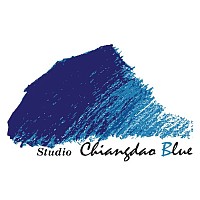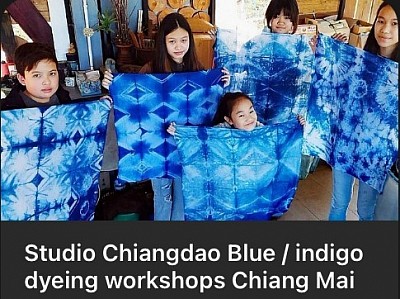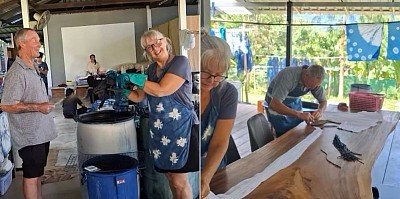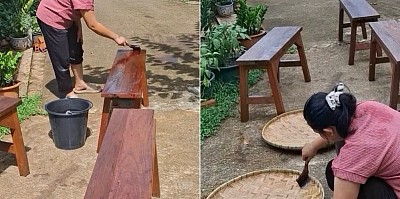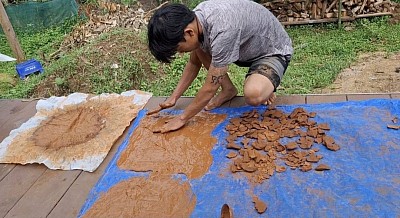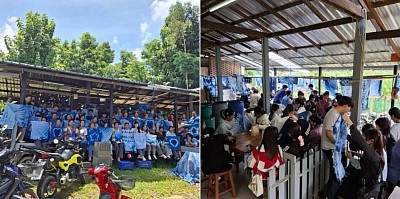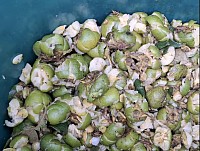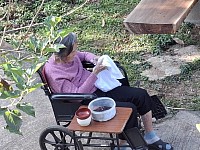Siripohn's Insights (Blog)
Homegrown Indigo Paste for Artists and Creators
Homegrown indigo paste — organically cultivated and extracted in small-scale batches using high-quality raw materials in well-balanced proportions — results in indigo paste with a high pigment concentration and a smooth, refined texture. It can be used as a natural blue pigment that is difficult to obtain, making it ideal for painting on paper, such as watercolor paper.
For anyone who enjoys painting and would like to try using indigo blue extracted from natural indigo leaves, please feel free to contact us through our website: www.chiangdaoblue.com.
A Day Filled with Love and Creativity
Another warm day filled with love, creativity, and a true mindfulness moment.
The gentle warmth and affection between the two of them made everyone in the studio feel happy and realize even more the power of love and care that Pam and Paul share.
Today’s activity was a gift from their son and daughter-in-law, who booked this workshop so that the parents could enjoy a fun and creative time together in a private atmosphere.
A cozy, private, and creative setting like this can offer not only a memorable experience but also a handmade piece that embodies the skills of Head, Hand, and Heart.
Chiangdao Blue truly wish to share this kind of memorable experience with families, couples, groups of friends, or individuals who wish to spend quiet and creative time with themselves.
Deepening Shades, Deepening Knowledge: Kakishibu on Wood Surfaces
On a sunny Sunday, perfect for kakishibu (persimmon dyeing), we used a batch of kakishibu solution that had been fermented two years ago and experimented with applying it onto wood surfaces. Our intention is to keep applying it layer by layer, patiently and without rushing—perhaps 40 to 50 times. So far, we haven’t even reached 20 coats, yet the color is already deepening little by little, which is very exciting.
The purpose of this experiment on wood surfaces goes beyond color dyeing alone. We also hope to explore kakishibu’s properties in preserving wood, preventing termites, and to discover after how many repeated applications the wood might finally gain water-repellent qualities.
Kakishibu dyeing has been a personal passion since my time living in Japan, where I also had the chance to dye fabric with it. The more I study and practice, the more I realize that this profound body of knowledge can truly become a lifelong work—something that must be approached gradually, through continuous practice and deepening understanding over time.
From Natural Colors to Self-Discovery: Ung’s Journey of Learning
Lately, the rain has lessened, and the days are sunnier, so our trainee Ung has begun preparing earth pigment powder for Bengara Zome dyeing. Based on the soil’s qualities, we decided to classify it into two types: the very fine powder will be reserved for dyeing with stencil techniques, while the coarser powder will be kept for immersion dyeing.
Our trainee Ung is a keen and dedicated student from the Non-Formal Education program (กศน.), eager to gain a wide range of experiences. From a shy, teenage boy who lacked confidence, Ung has started to explore himself through hands-on practice in the skills that interest him, engaging actively in training with an active learning approach. Now Ung has become more expressive and is able to reflect on his own thoughts and feelings.
I feel grateful that the process of natural dyeing has become another experience for Ung in his journey of self-discovery and growth. This simple yet profound activity, which takes time and patience, is another factor nurturing the identity of young people. It also reflects one of the deeper meanings of promoting Chiang Dao as a Learning City—a sustainable model grounded in self-reliance.
Indigo Dyeing Activity “from seed to dye” with Students from the Chiang Dao District Learning Promotion Center
This project focuses on strengthening vocational skills by enabling learners to study directly with local artisans in their own community. Today, each learner dyed two fabric pieces: a bandana and a scarf. After the activity, there was a reflection session where learners evaluated the experience using simple techniques that did not require filling out written questionnaires.
It was delightful to see that the students enjoyed themselves and expressed creativity based on a basic understanding of the dyeing process. They were able to produce interesting patterns, and the three-hour session passed by very quickly.
Our next hope is for learners to recognize ways to build on these skills—for example, starting with small collaborative projects such as making Father’s Day or Mother’s Day gifts by themselves using indigo dyeing techniques.
Today marks a small but meaningful first step, because one important goal of knowledge transmission is to help learners understand and see the opportunities to extend these skills in ways that will be beneficial for their own lives.
Chiangdao Blue: A Learning Hub with Local Artisans
Chiangdao Blue, as an official learning station for students of the Department of Learning Encouragement (DOLE), serves government-run non-formal education programs. Most students are already working, combining their jobs with non-formal learning under the new, more flexible education policy. This approach expands opportunities for students to learn practical skills directly from local artisans, enabling them to develop craft skills that can be built upon and turned into viable careers.
I truly admire this education policy, which understands the rapidly changing social and economic conditions—conditions that the traditional education framework may not be able to adapt to quickly enough.
Children and young people are the future of the nation. Empowering them with a diverse range of skills through hands-on practice and self-driven training is therefore highly appropriate and valuable.
Experimenting with hot dyeing using wild persimmon dye
Experimenting with hot dyeing using wild persimmon dye produced an orange-brown shade, which is the typical color obtained from persimmons. After that, the color was shifted using homemade rust water made from iron scraps.
It was found that the tannin in persimmons reacts very well with rust water. The wonder of the colors and properties from natural dyes is both exciting and full of potential for exploration, inviting scientific investigation into the origins and causes of these transformations.
When done by hand—seeing with the eyes and smelling the scents during the work—one can capture the subtle details in between the processes. These can then be expanded upon and developed further to discover new opportunities beyond the original framework, making it both a challenge and a joy.
Experiences like this, if children could participate in them firsthand, might give them new perspectives—ones that adults themselves might never have imagined.
Wild Persimmon Season Begins – Honoring Nature’s Wisdom
This year’s fermentation of wild persimmons has begun—slightly later than last year due to the heavy rainstorm last week.
I feel grateful to the forest, the mountains, the rain, and the rivers for creating such abundant natural resources. They nurture our ability to observe, and they empower us to apply our wisdom—wisdom that has been accumulated and passed down through generations.
Most importantly, this traditional knowledge is a crystallization of humble craftsmanship, deeply attuned to the rhythms of nature. That’s why I believe it is our generation’s mission to communicate and preserve these values, so they can be passed on to those who come after us.
The traditional wisdom of our ancestors reflects the true identity and essence of who we are. And the more rapidly technology advances, the more I believe that these values must go hand in hand—to help us maintain the balance we need for living a truly meaningful life.
The Creative Energy and Life Force of a New Generation Ready to Grow
Over the past four years of becoming part of the hands-on learning movement—centered on practical skill-building, self-reliance, and the philosophy of lifelong learning outside the traditional classroom—I’ve found myself surprised by how far I’ve come. At first, I believed I wasn’t good at interacting with young people, mostly because I had no experience raising children. But once I took my first step with the Chiang Dao: City of Learning project in collaboration with Makhampom Art Space, the more I became involved, the more I felt drawn in by the energy, the intrigue, the challenge, and the deep value of what we were building.
The more I did, the more perspectives I gained. The more I saw the endless possibilities hidden within each child—potentials just waiting to be “switched on.” Young people are the very source of creative energy, carrying the potential to shape society in new ways—ways that reflect the values they choose for themselves, often very different from the old frameworks set by adults.
Through working with local youth across many sessions, I’ve come to recognize the importance of intergenerational exchange. These moments create real opportunities for mutual learning, grounded in shared humanity. I feel deeply grateful—for having an open heart, for the Chiang Dao community that continuously supports these creative learning spaces, and for being able to feel a sense of ikigai in my daily life.
Indigo Story:
Indigo dyeing can generally be divided into two types:
1. Natural indigo dyeing, which uses pigment extracted from indigo plants.
2. Synthetic indigo dyeing, where the pigment is produced through industrial chemical processes.
In addition to the type of indigo pigment, dye vats can also be categorized into two main types: those using natural materials and those using chemical substances, some of which are not eco-friendly.
At Studio Chiangdao Blue, we follow a "from seed to dye" philosophy. We grow organic indigo without chemical fertilizers or herbicides. For preparing the indigo dye vat, we use traditional Thai knowledge—employing natural limestone-derived lye and tamarind extract. From cultivation and pigment extraction to dyeing, our entire process is health-conscious and environmentally friendly.
In Thailand, the culture of indigo dyeing has existed since ancient times, especially in the northeastern, northern, and southern regions. Each region has its own local indigo plant variety.
In the northeast, Indigofera tinctoria (straight-pod indigo) is common.
In the north, Strobilanthes cusia (locally called “hom”) is used.
In the south, Indigofera suffruticosa (curved-pod indigo) is prevalent.
Sakon Nakhon Province in the northeast is particularly famous for its indigo-dyed textiles. In the north, the “hom vat dyeing” tradition was once widely practiced in Phrae Province. However, due to the increasing scarcity of wild Strobilanthes cusia, most dyeing in Phrae today uses synthetic indigo. Only a few artisans still preserve the traditional natural hom dyeing.
In other northern provinces such as Chiang Mai, Lamphun, Chiang Rai, and Mae Hong Son, indigo dyeing still survives in highland ethnic villages—such as those of the Karen, Lahu, Hmong, and Akha.
Strobilanthes cusia requires a very specific environment to grow: shaded, cool mountain areas with abundant water. This makes cultivation and dyeing limited, and there is growing concern that hom-dyeing culture may disappear in the future. As a result, the north has begun cultivating Indigofera tinctoria and Indigofera suffruticosa as alternatives.
However, natural indigo dyeing requires both deep understanding of traditional wisdom—passed down through generations—and a scientific perspective. This combined knowledge can help make natural indigo dyeing more accessible to younger generations, creating a more contemporary, relatable, and sustainable practice that supports both human well-being and the environment.
Regarding health benefits, many people may not know that natural indigo plants have medicinal properties. In the past, Strobilanthes cusia and indigo plants were used to treat fevers in children. For venomous bites or stings, people would crush the leaves with sea salt, wrap the mixture in white cloth, and apply it to the skin to draw out toxins and reduce fever.
Besides indigo pigment, indigo leaves also contain other dye substances such as:
Flavonoids (yellow),
Indirubin (red),
and brownish compounds.
These compounds, including indigo itself, have antibacterial and UV-protective properties. That’s why, traditionally, indigo-dyed work clothes were popular in many agricultural countries, including Thailand and Japan.
For example, naturally indigo-dyed socks can help reduce foot odor after long hours of wear. People with sensitive skin may find relief by wearing naturally dyed indigo garments.
Given these many benefits, natural indigo holds great potential to create new opportunities—for reconnecting with nature, promoting well-being, and appreciating the value of the natural world in our daily lives.
A look back at the impactful reunion of the Makhampom Art Space community,
A look back at the impactful reunion of the Makhampom Art Space community, where we continued our commitment to Active Learning—empowering facilitators, educators, and artisans with holistic learning methodologies. This long-standing initiative has provided invaluable knowledge to teachers, students (both within and beyond formal education systems), as well as professionals in the fields of crafts and education, fostering a transformative approach to learning that keeps pace with the evolving demands of society and the modern world.
By equipping learners—both in and outside traditional education systems—with the necessary skills, techniques, and the freedom to shape their own paths, this initiative ultimately cultivates sustainable personal growth from within.
As one of the learning stations in this project, Chiangdao Blue strongly believes that natural indigo dyeing can serve as a meaningful pathway for nurturing young artisans. By mastering and applying this traditional craft, they can establish sustainable careers while preserving and carrying forward Thailand’s rich cultural heritage in craftsmanship.
Bamboo Sticks for Ita-Jime (Clamping) Pattern Making: A Sustainable Approach
The concept of sustainability is vast and multifaceted. At Chiangdao Blue, we embrace sustainability by prioritizing the use of locally sourced materials and exploring simple, traditional technologies. Our goal is to be as self-reliant as possible, minimizing external dependencies while maximizing the resources available in our surroundings.
This approach allows us to enjoy the process—a journey that deepens our connection with both our craft and the natural world. It fosters inner strength, cultivates a profound respect for nature, and instills a sense of pride in our work. By integrating sustainability into every step, we not only preserve traditional wisdom but also create meaningful and enduring art.
Life Lessons from My 90-Year-Old Mother
Despite her age and occasional struggles with emotional regulation due to dementia, my 90-year-old mother lives each day with intention, value, and meaning. She remains active, possesses a sharp memory, and constantly seeks to engage in productive work. Her current daily task is creating shibori patterns on high-quality cotton fabric in the "Furoshiki" style, measuring 70x70 cm. These fabric wraps serve as eco-friendly packaging for customers who purchase clothing from our shop, reducing waste from disposable packaging. Customers can later repurpose the Furoshiki as a bandana or in any other way they find useful.
Caring for the elderly in Thailand has increasingly become a challenge for children and families—a social issue that requires thoughtful attention. It is crucial for children to prioritize their aging parents' wellness and ensure they receive the close care they need. By centering our approach around our parents’ well-being, we can design a lifestyle that works for both them and ourselves. When we truly focus on this, we realize that we have more options than we initially thought. In fact, through this journey, we often discover new perspectives on life for ourselves as well.
One fundamental truth is that parents in their 80s and 90s have endured immense hardships for the sake of their children. Ensuring their happiness and wellness in their final years is not just an act of gratitude—it is a meaningful gift that strengthens our own hearts in ways we never expected.
Homegrown, Homemade Indigo Paste: A Captivating Choice for Artistic Expression
Extracted from the indigo plant, homegrown, homemade indigo paste offers an intriguing alternative for painting, evoking the aesthetic mood of traditional Chinese ink paintings in monochrome—only this time, in the mesmerizing blue-and-white palette of natural indigo. This enchanting blue hue, derived from a medicinal plant, carries a unique charm. Remarkably, the pigment extracted from indigo leaves isn’t limited to the iconic blue; hidden within are other shades, including yellow from flavonoids, red from indiburin, and brown tones. These pigments, with their medicinal properties, make indigo a truly remarkable natural gift.
Historically, indigo’s medicinal benefits extended beyond its use as a dye. In the absence of modern medicine, local communities relied on the plant for healing purposes. For instance, crushed indigo leaves mixed with a pinch of sea salt were wrapped in cloth and applied to insect bites. Similarly, these crushed leaves were used to reduce fever in children. The pigment, with its anti-bacterial and UV-protective qualities, embodies both beauty and functionality.
The timeless allure and medicinal properties of indigo deserve a place in modern life, adapted thoughtfully to fit our digital age. Beyond its physical benefits, this natural gift offers intangible rewards—instilling warmth, gratitude, and a sense of interconnectedness with nature. By embracing such treasures, we nurture a deeper appreciation for the delicate balance of our environment and the importance of its preservation. Let indigo, a legacy from nature, inspire both creativity and mindfulness in our daily lives.
